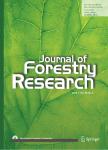Cultural knowledge of forests and allied tree system management around Mabira Forest Reserve,Uganda
Cultural knowledge of forests and allied tree system management around Mabira Forest Reserve, Uganda作者机构:College of Agricultural and Environmental SciencesMakerere UniversityP.O.Box 7062KampalaUganda National Forestry Resources Research InstituteP.O.Box 1752KampalaUganda National Agricultural Research OrganizationP.O.Box 295EntebbeUganda College of Natural SciencesMakerere UniversityP.O.Box 7062KampalaUganda CIRADTA 60/15.73Rue J-F Breton34398 Montpellier Cedex 5France CATIEApartado Postal 7170 TurrialbaTurrialba 30501Costa Rica
出 版 物:《Journal of Forestry Research》 (林业研究(英文版))
年 卷 期:2020年第31卷第5期
页 面:1787-1802页
核心收录:
学科分类:09[农学] 0903[农学-农业资源与环境]
基 金:The work was supported by the European Union under the French Agricultural Research Center for International Development(CIRAD)through a project entitled"Forest Restoration in Degraded Forest Landscapes of Eastern Africa and Indian Ocean Islands"(FOREAIM) within the FP6 framework(International Cooperation-Developing Countries[INCO-DEV] Contract INCO-CT-2005-510790)
主 题:Traditional Cultural ways Forest management Indigenous knowledge Superstition
摘 要:The cultural universe is sometimes confusing,surprising and murky,so many cultural maps get drawn,discussed and envisioned.A study was undertaken around Mabira Forest Reserve in central Uganda to identify the trees and shrubs culturally managed on-farm,assess the cultural practices of forest and tree system management and determine the relationship between farmer gender and forest and tree system *** engaged 203 farmers in focus group discussions and semi-structured interviews to collect *** data were jointly evaluated with farmers;quantitative data were analyzed in SPSS *** results showed a high likelihood for involvement of local people in tree or forest management for economic gain,as timber and fast-growing species were highly *** and medicinal species were also regarded as important,suggesting high prospects of integrating them into the local farming system or protecting them in the *** cultural practices(including rituals,trenching,bark slashing,ring barking,spot weeding and use of organic manure and pesticides)of forest and tree system management were ***,their knowledge was mixed and unclear about distinct cultural and supportive arrangements for natural forest and tree *** gender was not a significant cultural attribute for knowledge of the forest and allied tree system management,age substantially affected farmer propensity for various timber *** farmer’s family size influenced the collection of tree wildings and *** encourage considering gender disparities and livelihood needs including income,during selection of cultural practices for forest and tree restoration.



